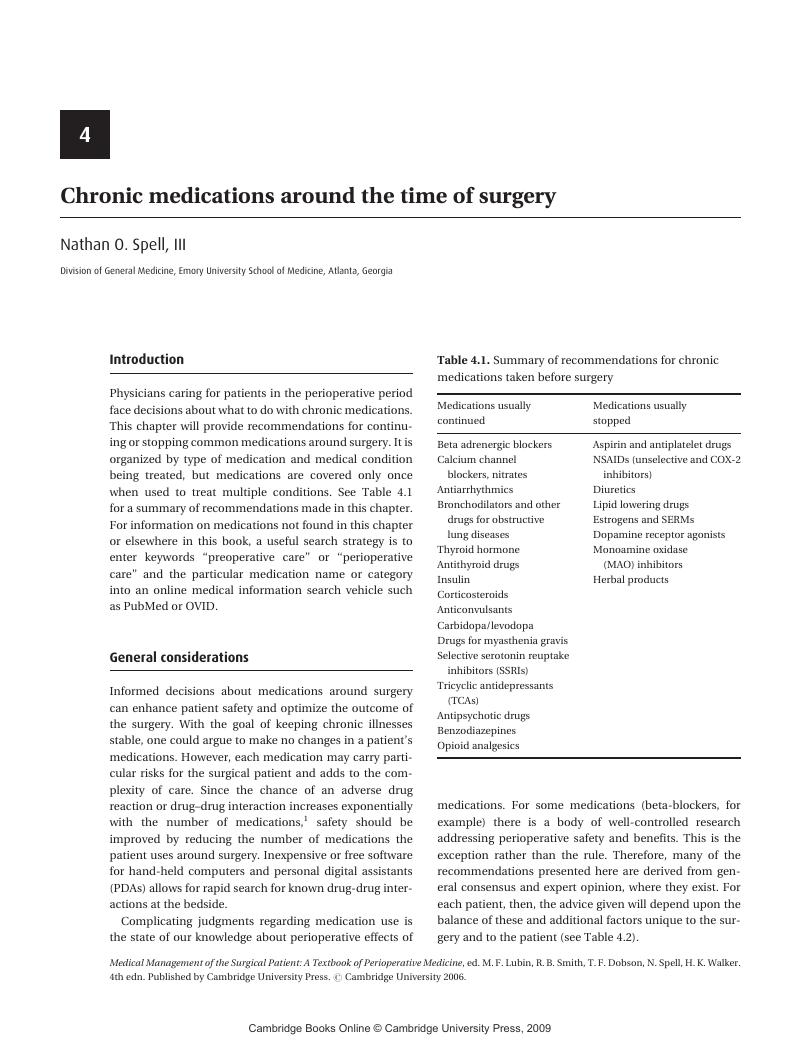Book contents
- Frontmatter
- Contents
- Editor biographies
- List of contributors
- Preface
- Introduction
- Part I Medical management
- 1 Anesthesia management of the surgical patient
- 2 Nutrition
- 3 Preoperative testing
- 4 Chronic medications around the time of surgery
- 5 Ethical considerations in the surgical patient
- 6 Cardiovascular disease
- 7 Postoperative chest pain and shortness of breath
- 8 Perioperative management of hypertension
- 9 Perioperative pulmonary risk evaluation and management for non-cardiothoracic surgery
- 10 Acute lung injury (ALI) and the acute respiratory distress syndrome (ARDS)
- 11 Postoperative pulmonary complications
- 12 Peptic ulcer disease
- 13 Liver disease
- 14 Inflammatory bowel disease
- 15 Postoperative gastrointestinal complications
- 16 Disorders of red cells
- 17 Assessment of bleeding risk in the patient with no history of hemostatic problems
- 18 Surgical issues affecting patients with hemotologic malignancies
- 19 Prophylaxis for deep venous thrombosis and pulmonary embolism in surgery
- 20 Blood transfusion/preoperative considerations and complications
- 21 Prevention of surgical site infections
- 22 Medical care of the HIV-infected surgical patient
- 23 Fever and infection in the postoperative setting
- 24 Surgery in the patient with renal disease
- 25 Postoperative electrolyte disorders
- 26 Diabetes mellitus
- 27 Disorders of the thyroid
- 28 Disorders of the adrenal cortex
- 29 Disorders of calcium metabolism
- 30 Pheochromocytoma
- 31 Rheumatologic diseases
- 32 Cerebrovascular disease
- 33 Management of the surgical patient with dementia
- 34 Neuromuscular disorders
- 35 Perioperative management of patients with Parkinson's disease
- 36 Delirium in the surgical patient
- 37 Surgery in the elderly
- 38 Obesity
- 39 Depression
- 40 Substance abuse
- 41 Care of the peripartum patient
- Part II Surgical procedures and their complications
- Index
- References
4 - Chronic medications around the time of surgery
Published online by Cambridge University Press: 12 January 2010
- Frontmatter
- Contents
- Editor biographies
- List of contributors
- Preface
- Introduction
- Part I Medical management
- 1 Anesthesia management of the surgical patient
- 2 Nutrition
- 3 Preoperative testing
- 4 Chronic medications around the time of surgery
- 5 Ethical considerations in the surgical patient
- 6 Cardiovascular disease
- 7 Postoperative chest pain and shortness of breath
- 8 Perioperative management of hypertension
- 9 Perioperative pulmonary risk evaluation and management for non-cardiothoracic surgery
- 10 Acute lung injury (ALI) and the acute respiratory distress syndrome (ARDS)
- 11 Postoperative pulmonary complications
- 12 Peptic ulcer disease
- 13 Liver disease
- 14 Inflammatory bowel disease
- 15 Postoperative gastrointestinal complications
- 16 Disorders of red cells
- 17 Assessment of bleeding risk in the patient with no history of hemostatic problems
- 18 Surgical issues affecting patients with hemotologic malignancies
- 19 Prophylaxis for deep venous thrombosis and pulmonary embolism in surgery
- 20 Blood transfusion/preoperative considerations and complications
- 21 Prevention of surgical site infections
- 22 Medical care of the HIV-infected surgical patient
- 23 Fever and infection in the postoperative setting
- 24 Surgery in the patient with renal disease
- 25 Postoperative electrolyte disorders
- 26 Diabetes mellitus
- 27 Disorders of the thyroid
- 28 Disorders of the adrenal cortex
- 29 Disorders of calcium metabolism
- 30 Pheochromocytoma
- 31 Rheumatologic diseases
- 32 Cerebrovascular disease
- 33 Management of the surgical patient with dementia
- 34 Neuromuscular disorders
- 35 Perioperative management of patients with Parkinson's disease
- 36 Delirium in the surgical patient
- 37 Surgery in the elderly
- 38 Obesity
- 39 Depression
- 40 Substance abuse
- 41 Care of the peripartum patient
- Part II Surgical procedures and their complications
- Index
- References
Summary

- Type
- Chapter
- Information
- Medical Management of the Surgical PatientA Textbook of Perioperative Medicine, pp. 40 - 46Publisher: Cambridge University PressPrint publication year: 2006



